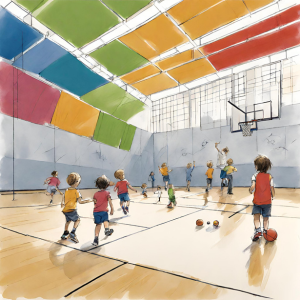Acoustic Design in Schools
Ensuring Optimal Learning Environments
Heyda Provides Expert Acoustic Design Services for Educational Facilities
The acoustic environment in schools plays a crucial role in both teaching and learning. Effective acoustic design is essential to create spaces conducive to education, minimise distractions, and comply with regulatory requirements. This page explores the multifaceted approach to acoustic design in schools, adhering to standards like BB93 for compliance with Part E of the Building Regulations.

The Acoustic Design Process
- Noise Survey and Assessment: The process begins with a comprehensive noise survey. This assessment involves measuring external noise sources, such as traffic or industrial activities, to understand their impact on the school site.
- Acoustic Design Development: Based on the survey and the proposed design aspirations, acoustic consultants develop a design strategy. This includes specifying building materials and construction methods that provide adequate sound insulation, noise reduction and room acoustic conditions.
- External Noise Levels: External noise levels are often plotted as noise maps to ensure that external noise levels in playgrounds and external teaching spaces are suitable for the proposed usage. Barriers such as fences or earth bunds can be specified to reduce noise levels from road traffic or similar noise sources.
- Internal Noise Levels: Design considerations are made to shield classrooms from external noise, ensuring minimal disturbance. These include specification of an appropriate ventilation strategy, and determining the sound reduction performance requirements for external windows, doors, walls and roofs.
- Internal Sound Insulation: Effective insulation between rooms prevents sound transfer, crucial throughout schools, but especially in areas like music rooms or for rooms in the school used by students with special hearing or communication needs. The acoustic consultant calculates the required sound reduction performances for internal walls and floors and recommends build-ups for these structures that are then specified by the architect.
- Building Services Noise: HVAC systems, lighting, and other services are designed to operate quietly, minimising background noise so that appropriate internal and external noise conditions are maintained. The acoustic consultant will set the internal and external noise level requirement, and can predict the noise level from proposed building services systems, recommending attenuation such as in-duct silencers, plant enclosures, or barriers.
- Room Acoustics: Particular attention is given to room acoustics, by ensuring there is sufficient absorbent material within each teaching space to meet the reverberation time requirements. This is to ensure good speech intelligibility (from teacher to student for example) and a comfortable auditory environment. The acoustic consultant sets the room acoustic criteria and undertakes calculations and modelling to determine the expected rev time in each space. Recommendations can then be made regarding any additional absorptive finishes required, such as wall panels, which can then be added to the architectural drawings.
- Design Review and Adjustments: The design is reviewed periodically, with adjustments made based on evolving requirements or challenges encountered during construction.
Commissioning and Post Completion Testing
Post-construction, acoustic commissioning involves rigorous testing to ensure all areas of the school meet the designed acoustic criteria.
Typically, one in every four teaching spaces require acoustic testing that covers airborne and impact sound insulation, reverberation times, and internal ambient noise levels.
This phase confirms that the school’s acoustic environment aligns with the initial design intentions and regulatory requirements.

Conclusion

Acoustic design in schools is a vital element that significantly influences the quality of the educational environment. Adhering to established standards and following a comprehensive, step-by-step approach from initial assessment to final commissioning enables us to create spaces where both students and teachers can excel.
At Heyda, we offer a complete range of services to guide your educational development from its conceptual stages, through planning and design, to construction, and finally to commissioning.
James Williams, our Director at Heyda, brings personal experience from successfully completing over 50 education projects. This wealth of expertise positions him perfectly to provide the bespoke acoustic solutions your school requires. With a focus on creating conducive learning atmospheres, Heyda is committed to ensuring that every educational space is acoustically optimized for the benefit of all its users.
Further Reading/Resources
Talk to us
Contact Heyda today for a specialised consultation. Together, let’s design educational spaces where sound quality significantly contributes to the learning experience, fostering focus and understanding. Reach out to us, and let’s transform the acoustic environment of your school.
